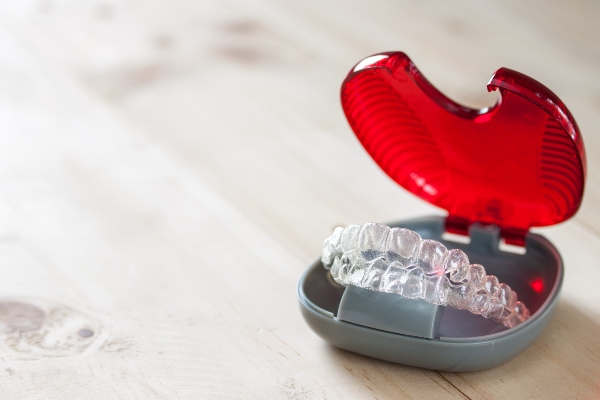 Invisalign® treatment demands wearing the aligners for at least 22 hours a day. Read on to learn more about what it is like to sleep while wearing Invisalign aligners. The only time you should take your Invisalign aligners out of your mouth is to eat, drink anything other than water, and brush your teeth. That implies that you need to wear the Invisalign trays at night while sleeping to achieve correct tooth alignment. It may feel strange sleeping with a foreign object in your mouth at first, but it will soon become second nature, and you will fall asleep as effortlessly as you did before the teeth straightening treatment started.
Invisalign® treatment demands wearing the aligners for at least 22 hours a day. Read on to learn more about what it is like to sleep while wearing Invisalign aligners. The only time you should take your Invisalign aligners out of your mouth is to eat, drink anything other than water, and brush your teeth. That implies that you need to wear the Invisalign trays at night while sleeping to achieve correct tooth alignment. It may feel strange sleeping with a foreign object in your mouth at first, but it will soon become second nature, and you will fall asleep as effortlessly as you did before the teeth straightening treatment started.
Adjusting to Invisalign aligners during sleep
Invisalign aligners are made from clear thermoplastic that is almost invisible to the naked eye. They operate by applying pressure to teeth, causing the bone supporting the teeth to react and recede in the correct direction. Bone fills in from the opposite side when the tooth shifts position. This causes the teeth to realign over time.
The mouth may stay slightly ajar while sleeping during the first few nights as the patient acclimates to the aligners, and there could be an increase in nocturnal salivation and drooling. The orthodontist will recommend sleeping with the head raised and looking upward to reduce this. It helps to keep a glass of water nearby to counteract any dry mouth due to leaving the mouth open.
Looking at the big picture, the increased nocturnal drooling and early pain are minor annoyances, and the beautiful smile that is attainable with Invisalign will make it worth it eventually. Wearing the Invisalign aligners at night will not only ensure proper teeth straightening but will also act as a barrier between teeth, shielding them from the damaging effects of nocturnal grinding. In comparison to metal braces, this protective aspect provides an extra advantage.
Nighttime use of Invisalign aligners
Invisalign works because of the near-constant pressure. Therefore, it is necessary to wear the aligners during sleep. The manufacturers of Invisalign suggest wearing the braces for 20 to 22 hours each day and only removing them while eating or brushing the teeth.
It is not a good idea to remove the aligner trays while sleeping. They will not function as fast if they do not provide continuous pressure. If patients stay too long without using Invisalign, the teeth may return to their original position, and they will have to restart the treatment from scratch.
If patients neglect to wear their Invisalign aligners at night for a few days, such as when on vacation, they may experience pain when putting them back on. This is a common side effect of the teeth moving out of alignment.
Within a few days, the pain should go away. If it does not, it means the teeth may have moved to the point where the Invisalign has to be adjusted. The chances are that the patient will have to go back to a previous Invisalign aligner tray until the teeth adjust again.
In summary
It is important to wear Invisalign aligners for the minimum number of hours recommended. This will ensure treatment progresses optimally.
Request an appointment or call Brentwood Family Orthodontics at 310-750-4621 for an appointment in our Los Angeles office.
Related Posts
Invisalign® is a modern teeth-straightening option that serves as an alternative to metal braces. Invisalign eliminates the need for brackets and wires; instead, it uses a series of clear plastic aligners to realign the teeth. Although lots of individuals are aware of the aesthetic advantages of Invisalign, like a straighter smile, there are also health…
Invisalign® is a breakthrough orthodontic technology that uses a series of transparent aligners to enhance the look of crooked, overlapping, and gapped teeth. If you are considering using Invisalign for your orthodontic treatment, you may be curious about how often you would have to go for checkups and what happens during those appointments. Continue reading…
Invisalign® aligners are a popular alternative to conventional metal braces. Although Invisalign offers more comfort than metal braces, it is impossible to eliminate the chances of mild pain or discomfort. The risk of discomfort seems to be highest during the first week of wearing invisible teeth aligners.A person’s pain tolerance also determines the degree of…


